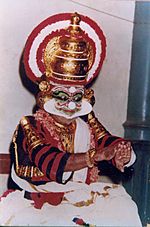Performing arts facts for kids

Performing arts are exciting types of art where people use their own bodies, voices, and presence to create a show. Unlike visual arts (like painting or sculpting), performing arts are live. They happen right in front of you! The artist is the art.
Visual arts use materials like clay, metal, or paint to make physical objects. But in performing arts, the performance itself is the main artwork. The idea of 'performing arts' first came about in English in 1711.
Contents
Types of Performing Arts
The world of performing arts is huge! It includes things like dance, music, opera, drama, magic, public speaking, and circus acts.
People who perform in front of an audience are called performers. This group includes actors, comedians, dancers, magicians, musicians, and singers. Many other people help behind the scenes too. They might write songs or work on the stage setup.
Performers often change how they look for a show. They might wear special costumes or use stage makeup.
There's also a special kind of fine art called performance art. Here, artists perform their work live for an audience. This often uses some visual art too, like making props for the show.
Music
Music is a big part of the performing arts. People can choose different paths in music. Some become performers, playing instruments or singing. Others might teach music to students. There are also people who study music theory or its history.
Students learn to play instruments and also study how music is put together. Music can also help people who aren't musicians. It teaches skills like focusing and listening carefully.
Drama

Drama is all about telling stories in front of an audience. It uses acting, talking, gestures, and often music or dance. It can also include sounds and amazing sights.
Plays are a common form of drama. But drama also includes musicals, opera, ballet, and illusion shows. Other forms are mime, Indian dance, kabuki, and stand-up comedy. Even pantomime and unique arthouse theatre are part of drama.
Dance
Dance is usually about human movement. It can be a way to express feelings or used in social gatherings. Dance is also important in spiritual events or performances.
The word 'dance' can also describe other things. It can mean non-verbal communication between people or animals. Think of a bee dance or a mating dance. It can even describe motion in objects, like the leaves danced in the wind.
Choreography is the art of creating dances. The person who makes dances is called a choreographer.
What counts as dance can change from one society to another. It ranges from folk dance to highly skilled techniques like ballet. In sports, rhythmic gymnastics, figure skating, ice dancing, and synchronized swimming are types of dance. Some martial arts even have moves that look like dance.
History of Western Performing Arts
The first recorded performing arts in the West started in Ancient Greece. This was around the 6th century BC. Famous tragic poets like Aeschylus and Sophocles wrote plays. Some of these plays even included dance, as seen in the works of Euripides. Aristophanes was known for his funny satirical comedies in the 5th century BC.
By the 6th century AD, Western performing arts mostly stopped. This was during a time known as the Dark Ages. Between the 9th and 14th centuries, performing art in the West was mainly religious. The Church organized plays about religious history. They also put on morality plays for holy days and other important events.
Images for kids
-
Scene from the ballet Les Sylphides
-
Commedia dell'arte troupe on a wagon, by Jan Miel, 1640
-
Vaslav Nijinsky dancing the Faun in L'après-midi d'un faune (1912)
-
Bharatanatyam an Indian classical dance originated in Tamil Nadu
-
Gotikua folk dance is one of the well known performance performed by all boys group dressed in Indian ladies attire Saree
-
Hanuman on his chariot, a scene from the Ramakien in Wat Phra Kaew, Bangkok
-
Performance in Kagoshima
See also
 In Spanish: Artes escénicas para niños
In Spanish: Artes escénicas para niños














